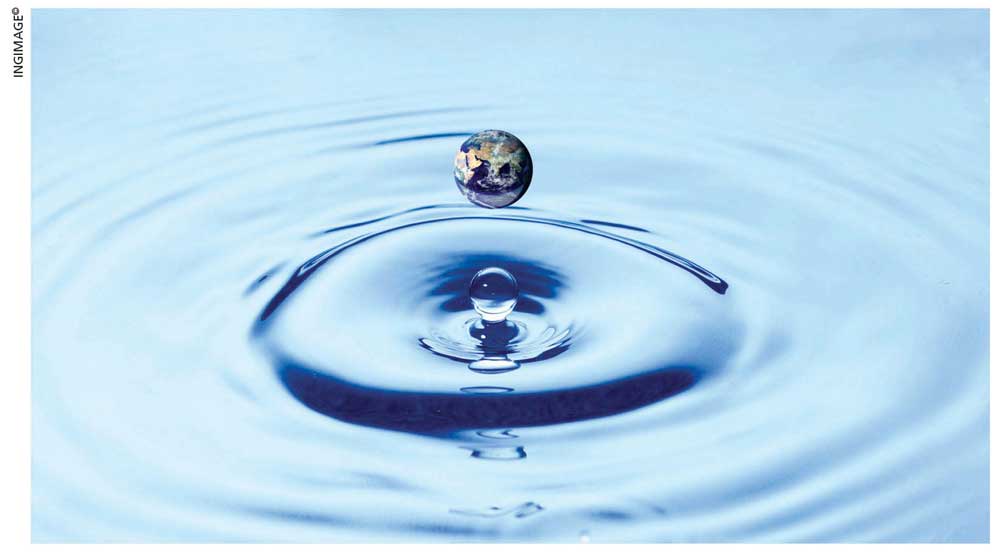WATER CONSERVATION
TANKING UP ON A LIFEBLOOD
Janaka Perera highlights the need to pursue water management efficiently

Water is a fundamental part of life, and can be a game changer for poverty reduction, health and wellbeing. And it’s inextricably linked to sustainable development – and has social, cultural, economic and political indicators.
Sri Lanka’s economic transformation was made possible mainly by its water resources. Since ancient times, this vital natural resource has been intertwined with the lives of the people. Our agricultural economy bears testimony to the historical and cultural links between water and the citizenry.
Ancient kings built an abundance of reservoirs to cultivate acres of paddy fields, and crop yields – along with the lives of farmers and their families – improved as a result.
Though there are no large-scale natural reservoirs, Sri Lanka is endowed with man-made tanks together with an efficient canal system for irrigation. Some of these ancient tanks have been rehabilitated and about 14,000 of them dot the Dry Zone.
Their areas range from one to 65 square kilometres. The cascade system created through the interconnection of several such tanks in the Dry Zone is another important component of the country’s conservation process.
But due to the uncontrolled abstraction of groundwater for domestic and agricultural uses, brackish water is intruding into coastal areas. According to sustainability collaboration Water Action Hub, economic development, population pressure and growing demand for food production, electric power and sanitation services are placing increasing pressure on water resources.
Meanwhile, the demand for water has outstripped supply, particularly in the Dry Zone where most irrigation schemes are located.
The benefits of water can be fully realised only through the effective and safe management of water resources. Efficient sanitation and hygiene facilities, together with raising awareness, can be lifesaving and cost-effective health interventions. Without these, infectious diseases are more likely to spread, posing threats to infants and children.
Water Action Hub avers that the government spends around US$ 45 million annually to provide the population with piped water. The island’s only public sewer system is in Colombo and it serves an estimated 20 percent of the metropolitan region.
However, the collection isn’t treated effectively. Very few industries have treatment plants while others discharge effluent directly into waterways.
There are some 15,000 tube wells in Sri Lanka, and the quality of the groundwater is quite good and relatively constant throughout the year. In some parts of the country (e.g. its northern and northwestern coastal areas) however, there are reports of excessive concentrations of iron and nitrates, due to agrochemical and fertiliser use.
The economic crisis resulted in an acute shortage of water testing chemicals. Consequently, around two million people in urban, plantation and rural areas were deprived of adequate or regular access to safe drinking water sources.
At the outset of the economic crisis, nearly half the households in Sri Lanka were not able to observe water treatment protocols such as boiling or chlorination.
The UN aims to ensure safe drinking water for 1.7 million of the most vulnerable people in Sri Lanka who are in urgent need of humanitarian assistance. This will result in the improvement of crop yields and lives of farming families.
Water is increasingly being used in manufacturing, power generation and construction. The water intensive apparel industry is one of the main drivers of industrial growth and the country’s leading export sector – it accounts for more than 40 percent of Sri Lanka’s exports and employs over 10 percent of the labour force.
The tourism industry, which employs more than 350,000 people, relies heavily on water to run hotels and provide services. It’s the third largest source of foreign exchange earnings in the country and estimated to contribute 4.5 percent to GDP.
Sri Lanka’s water resources are critically important to sustain the island’s socio-ecological integrity and achieve the UN’s Sustainable Development Goals (SDGs).
Major environmental problems affecting water quality, human health and ecosystems include deforestation, soil erosion, wildlife populations threatened by poaching and urbanisation, coastal degradation due to mining activities, pollution of freshwater resources by industrial waste and sewage runoff, inefficient waste disposal and air pollution.
The government has initiated many watershed and water resources management programmes that focus on diverse geographical areas to address these challenges. And the Sri Lanka Water Resources Management Project was implemented in response to the anticipated economic, social and environmental losses due to current water resources management challenges.
Systematic implementation of this project is expected to address some of the adverse impacts of climate change in the country.




